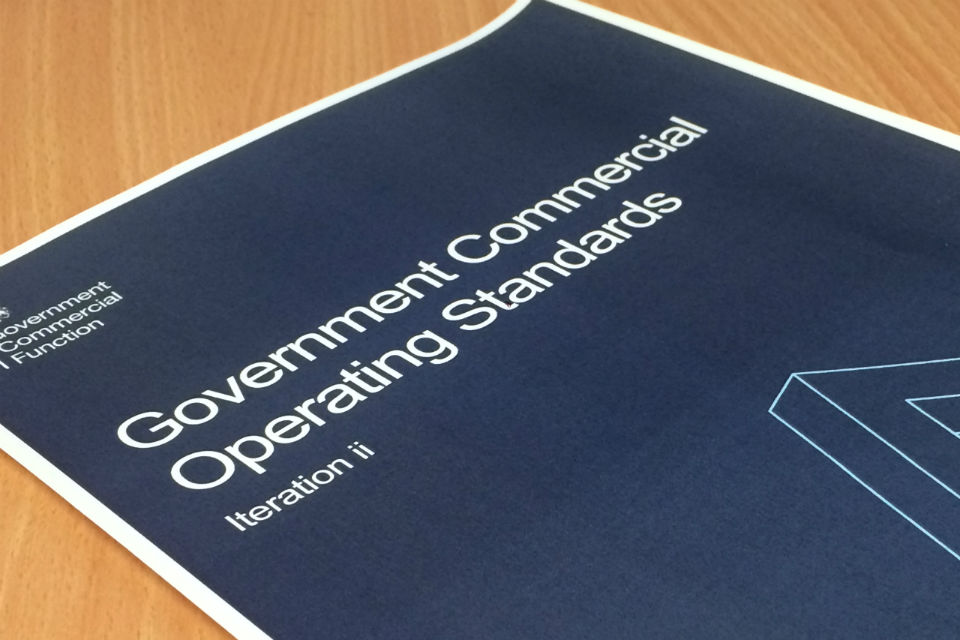
On the morning of 15 January, Carillion, a major supplier of services to government, declared itself insolvent and went into liquidation. From the initial profits warning on 10 July 2017, the Cabinet Office intensified its work with other government departments to monitor the company’s financial position and plan for the possibility of its collapse.
This was not the outcome we wanted, but by planning for it we achieved our first priority of avoiding damage to the delivery of vital public services. How we managed this would test the robustness of the functional arrangements we had put in place over the previous two years. It is widely acknowledged that the function passed this test, through effective contingency planning and resilient contracting (whereby other suppliers were part of joint ventures and were committed to step in to cover Carillion’s obligations), working with operations colleagues across the country.
Our success was in great part due to our working as a function. There are now 10 core functions in operation across the Civil Service, including Commercial, complemented by professional networks connecting civil servants right across government.
Having an effective commercial function is important not only for managing a crisis, but also for delivering normal business.
What is the Commercial Function?
The Government Commercial Function (GCF) consists of 4,000 commercial staff who work across government. They are connected through knowledge-sharing systems and common operating standards, and led by the Commercial Function Leadership Group of commercial directors in every central government department, chaired by the Government Chief Commercial Officer.
Most of the function (about three-quarters) sits in government departments and delivers the commercial strategy for their particular department. The rest sit in either the Crown Commercial Service (CCS), which buys common goods and services, or the Central Commercial Teams in Cabinet Office, who support commercial capability, market intelligence and strategic supplier relationship management, complex transactions and continuous improvement.
The GCF is also supported by the Government Commercial Organisation (GCO), which recruits and directly employs (on standard contracts) the most senior 300 commercial staff who are then deployed back into their host departments. The GCO is underpinned by a robust assessment process for accrediting senior commercial staff (internal or externally recruited) and a substantial training and development programme to support them.
This is because commercial activities account for significant spending across government and the wider public sector. The latest estimate from the National Audit Office (NAO) shows that central government spent around £49 billion on commercial contracts in 2016/17 (excluding capital spending, intangible assets and PFI interest).¹
During the same financial year (2016/17), the Government Commercial Function (GCF) saved around £2 billion by securing better commercial deals. This is achieved by making smarter decisions in specifying what we need to buy, using our collective purchasing power to get the right price, and being better at managing the contracts that flow from these decisions. But it is not just about cost savings. Functions make it easier for colleagues to collaborate across government, share good practice and, as a result, support the delivery of better services. Also, as seen with Carillion, functions make us more resilient.

Managing our biggest suppliers
Another benefit of working as a function is that it makes us better at managing the relationships with our biggest suppliers. The largest 27, known as ‘strategic suppliers’, are so important that we have put in place pan-government systems for managing our relationships with them. The Markets & Suppliers area of the central GCF teams take a whole-government perspective, working with commercial colleagues across departments.
Strategic suppliers also have a nominated ‘crown representative’. This is a senior figure with a commercial background, who acts as the main point of contact between top executives of the supplier and the Government, working alongside our supplier partnering managers. Although the Carillion crown rep role was vacant for a period, the combination of the supplier partnering manager and the increased involvement of other senior staff (including myself) meant our engagement with the company wasn’t affected.
Our approach to managing our strategic suppliers proved vital in the contingency planning for Carillion. In the run-up to the company’s collapse, commercial and operational teams came together from across government and the wider public sector, including the Cabinet Office, Ministry of Justice, Department of Health and Social Care, the NHS, Department for Transport, Department for Education and more. While keeping in close contact with Carillion, large numbers of staff worked over a period of months and put in place more than 65 contingency plans, from 26 public bodies, covering 154 Carillion contracts.
Because the network of commercial professionals working as a function had already been established, it was easier to determine the extent of the Government’s contractual arrangements and initiate contingency planning. We were able to spot commonalities across many contracts and put in place ‘umbrella’ plans. These ensured that crucial public services were maintained following the failure of the company.
Speaking about the Carillion collapse in a speech on Civil Service transformation, Civil Service Chief Executive John Manzoni said: “If this had happened two years ago, we would not have had the expertise or cross-government structure to manage it.”² Similar reflections have come from independent commentators, including Julian McCrae of the Institute for Government.³
Indeed, such is the progress we have made in building capability and cross-functional working, that some vendors worry that the balance of professional expertise has shifted towards us, and that we are now negotiating deals that make it difficult for them to make a profit.⁴ However, while we need to get good commercial deals, this would miss the point if we were driving vendors out of business. We need a strong supply chain. Vendors making a reasonable profit, in exchange for delivering the agreed services, is in everyone’s interest.
Where next?
Progress has been made, acknowledged by both external and internal stakeholders, but there is a big programme of further improvement ahead to complete the transformation of the Commercial Function.
The Government Commercial Operating Standards set out a consistent operating model across departments.⁵ Specific standards look at how central government departments manage areas such as ‘commercial pipeline and planning’, ‘maximising competition’ and ‘contract management’. Commercial teams in departments and wider public bodies are measuring themselves against these standards in order to identify where they have the greatest need for improvement and areas of strength they can showcase to others.

Putting contracts in place is only half the story. A number of reputable bodies estimate that good contract management can save around 10% of the contract value. Estimates of the numbers of civil servants involved in managing contracts and suppliers range from 12,000 to 100,000. The vast majority of these staff sit outside the Commercial Function. The new Contract Management Professional Standards set out our expectations of everyone involved in this important area.⁶ We are identifying contract managers and assessing their skills against these standards so that we can give them the training and development they need to become accredited. This will give them, their departments and us confidence in their ability to manage effectively the contracts they are responsible for.
Transforming contract and supplier management
For all of our suppliers, large or small, good contract management is essential if we are to get the best from them. The Ministry of Justice (MOJ) has placed great emphasis on transforming its contract management capability, and we are seeing real results. An example is the Courts Language Service. At the end of 2016 the service was re-tendered and most of it was awarded to a new supplier. Around 750 court cases each day require interpreters. Because of effective contract management, a high level of performance was maintained through the contract transition, getting the right interpreters to the right courts on time. This avoided the postponement of hundreds of court cases each day that happened during the previous change-over.
Contract management staff in the commercial teams of the MOJ and 16 other departments worked as a GCF team to develop a contract management toolkit and guide for our online knowledge sharing platform (the GCF Knowledge Hub). With around 20,000 page views, it is widely used, helping to strengthen contract management across the Commercial Function. The toolkit, which has drawn on standards set by industry professional bodies and the NAO, won a top award in the 2018 UK GO Excellence in Public Procurement Awards.
When you combine the £49 billion of commercial contracts that central government is responsible for, and with the commercial spending of wider public bodies, the NAO believes that the total amount involved is £192 billion (or £251.5 billion, if you include capital spending, intangible assets and PFI interest).⁷ This is why we are delivering a programme to support arms’ length bodies (ALBs) that deliver vital services and account for major spending. Our successful assessment and development centre has assessed over 1,100 civil servants and external candidates to fill our 300 most senior roles. We are now offering this service to ALBs alongside a tailored training and development programme.
Becoming the best
Our vision is to make the Government Commercial Function the best commercial function in the UK. The scale of our spending and the services that we buy are too significant for us to settle for second best. Watch this space as we continue on our journey of improvement.
¹ ‘A Short Guide to Commercial Relationships’, National Audit Office, December 2017.
² John Manzoni, Chief Executive of the Civil Service, speech at the LSE on Civil Service Transformation, 24 January 2018.
³ Julian McCrae, Senior Fellow at Institute for Government, tweet on 25 April 2018: ‘…Risks are clear. But govt also getting better at handling them. Existence of govt commercial function means Carillion handled far better than was possible even a few years before. And signs are that function using experience to push next round of improvement.’
⁴ Civil Service World online article (23 February 2018): ‘Improved government commercial skills have hit outsourcers, says Serco chief’.
⁵ Government Commercial Operating Standards, published 4 February 2016.
⁶ Contract Management Professional Standards, published 22 February 2018.
⁷ ‘A Short Guide to Commercial Relationships’, National Audit Office, December 2017.
Recent Comments